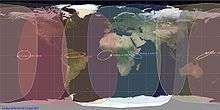Vortex (satellite)
Vortex, previously known as Chalet, was a class of spy satellite operated by the United States during the 1980s and 1990s to collect signals intelligence (SIGINT) from high Earth orbit. The Vortex satellites were operated by the National Reconnaissance Office for the United States Air Force and listened to radio transmissions originating from Earth or space. The intercepted data is believed to have been fed into and analyzed by the National Security Agency ECHELON system.

The satellites each had a mass of approximately 1,800 kilograms and are operated from non-stationary geosynchronous orbits. Each reportedly carried a 38-meter-diameter umbrella-like reflecting dish to collect radio signals from Earth. At least six launch attempts were made of Chalet/Vortex satellites between 1978 and 1989. The Chalet/Vortex satellites replaced the older generation of Canyon satellites, and were superseded by the larger, more capable Mercury satellites.
Launches
| Name | COSPAR ID SATCAT № |
Launch date (UTC) |
Launch vehicle | Launch site | Orbit | Remarks |
|---|---|---|---|---|---|---|
| OPS 9454 | 1978-058A 10941 | 10 June 1978 19:08 | Titan III(23)C | CCAFS LC-40 | ||
| OPS 1948 | 1979-086A 11558 | 1 October 1979 11:22:00 | Titan III(23)C | CCAFS LC-40 | ||
| OPS 4029 | 1981-107A 12930 | 31 October 1981 09:22:00 | Titan III(23)C | CCAFS LC-40 | ||
| OPS 0441 | 1984-009A 14675 | 31 January 1984 03:08:01 | Titan III(34)D/Transtage* | CCAFS LC-40 | ||
| USA-31 | 1988-077A 19458 | 2 September 1988 12:05:02 | Titan III(34)D/Transtage | CCAFS LC-40 | ||
| USA-37 | 1989-035A 19976 | 10 May 1989 19:47:01 | Titan III(34)D/Transtage | CCAFS LC-40 | ||
- * – The rockets used for the first three launches also included Transtages, however it was considered an integral component of the Titan III(23)C rocket, and an additional upper stage for Titan III(34)D launches.
See also
- Magnum SIGINT satellites – a similar, contemporary program run for the Central Intelligence Agency
- Mercury or "Advanced Vortex" SIGINT satellites – replacements for Vortex
References
- Richelson, Jeffrey T. ed. U.S. Military Uses of Space, 1945-1991 Vol 1, Guide. National Security Archive. 1991.